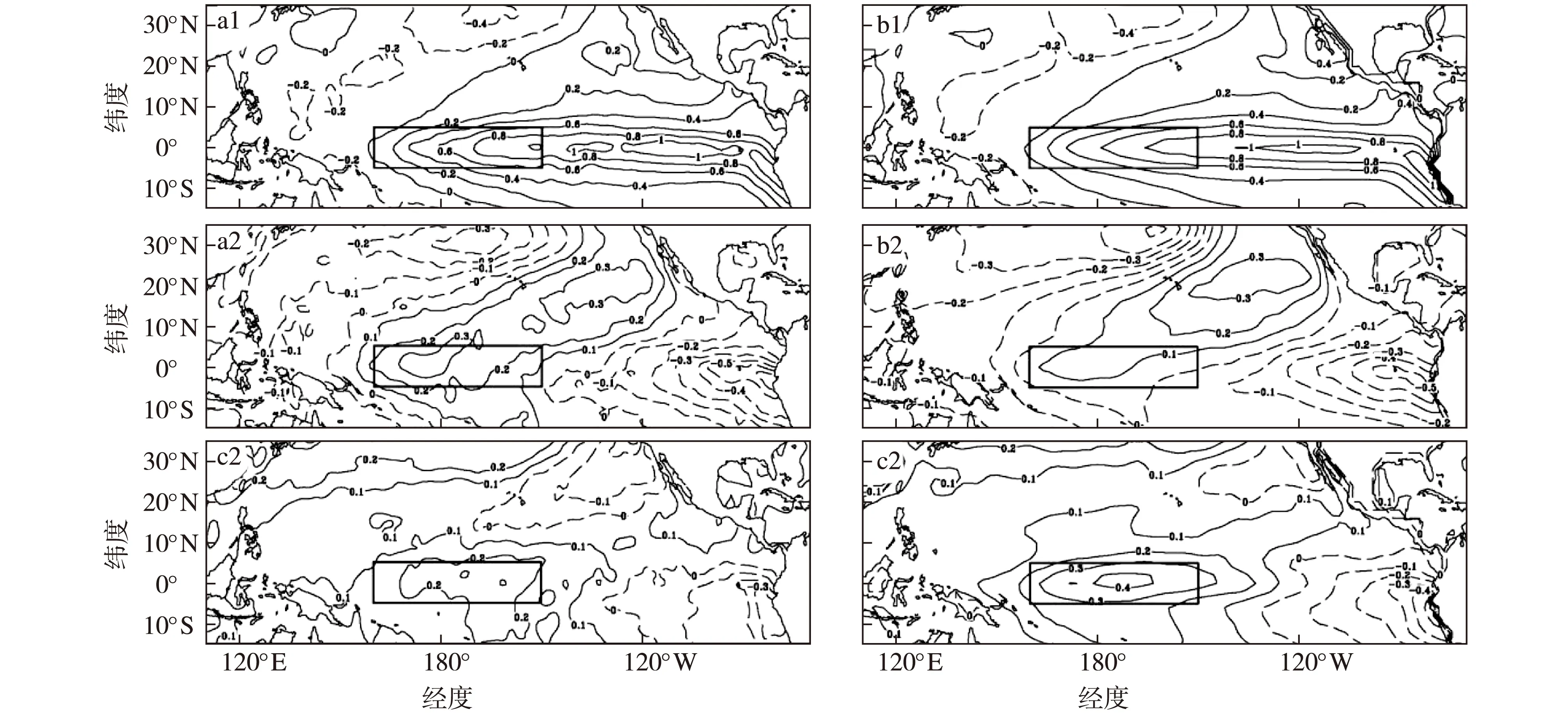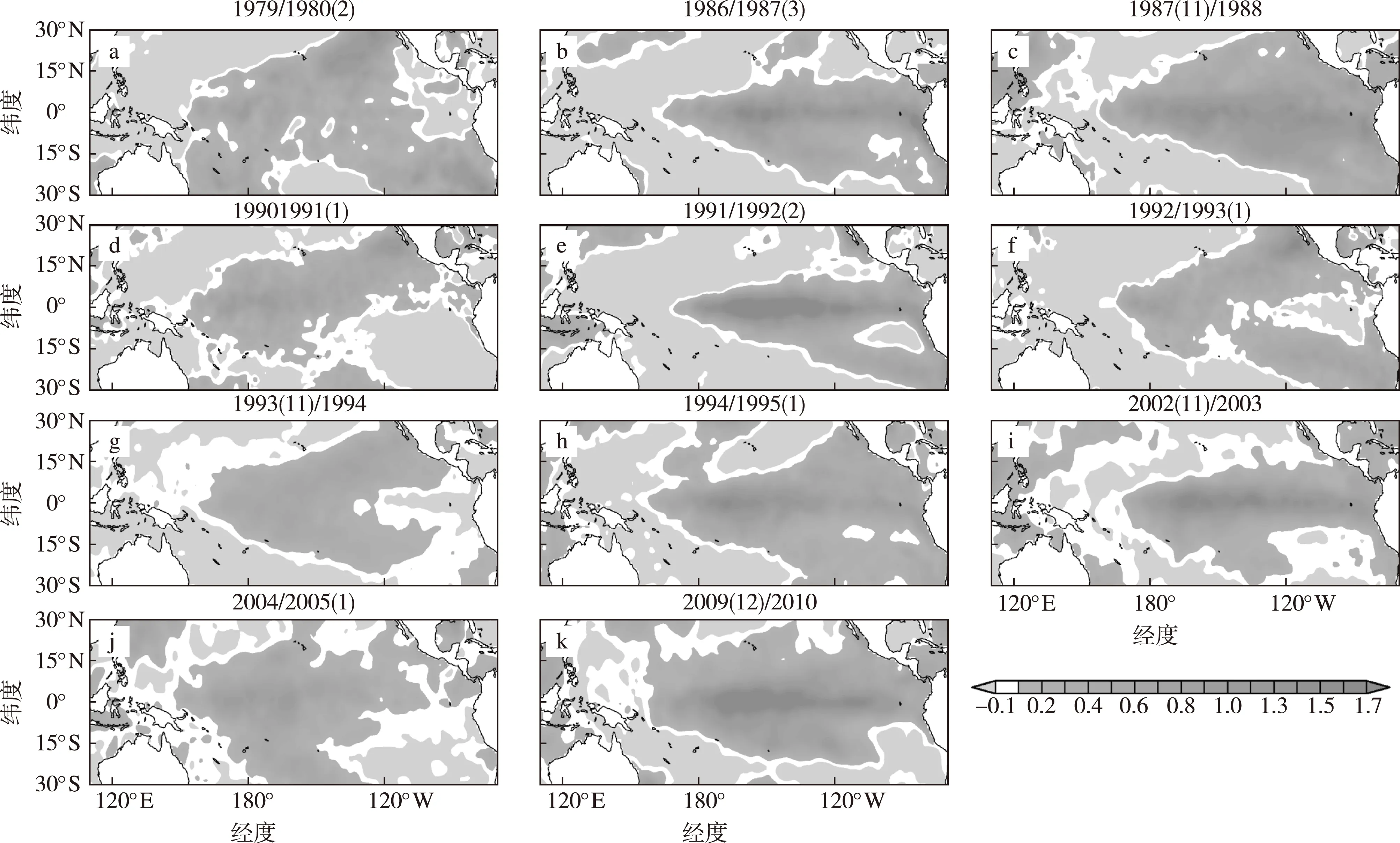两类中太平洋El Niño特征的对比分析
张攀全,郭品文,董丽娜,尹依雯,沈沉
南京信息工程大学 气象灾害预报预警与评估协同创新中心/气象灾害教育部重点实验室,江苏 南京 210044

两类中太平洋El Niño特征的对比分析
张攀全,郭品文*,董丽娜,尹依雯,沈沉
南京信息工程大学 气象灾害预报预警与评估协同创新中心/气象灾害教育部重点实验室,江苏 南京 210044
2015-11-09收稿,2016-01-29接受
国家自然科学基金资助项目(41305079)
利用1979—2012年逐月Hadley中心海表温度、欧洲中期天气预报中心次表层海温、NCEP/NCAR风场再分析资料,对两类中太平洋(CP)El Niño及耦合的大气环流特征进行分析。结果表明,第一类CP El Niño(CP-Ⅰ El Niño)增暖中心位于Niño4区且关于赤道对称;第二类CP El Niño(CP-Ⅱ El Niño)的Niño4区与热带东北太平洋区域(NEP,130~110°W、15~25°N)同位相变化,冬季成熟后形成关于赤道非对称的带状增暖结构。进一步的研究表明,两类CP El Niño次表层结构存在差异:CP-Ⅰ El Niño冬季次表层海温异常(SOTA)在中东太平洋与西太平洋呈显著偶极分布;CP-Ⅱ El Niño在中、西太平洋位相相反但东太平洋异常较弱,且经向异常主要在赤道及其以北。两类CP El Niño耦合的大气环流特征不同:CP-Ⅰ El Niño冬季异常Walker环流上升中心位于赤道上空,经向风向赤道辐合,低纬地区Hadley环流加强;CP-Ⅱ El Niño冬季低层向北越赤道气流加强,Walker环流上升中心移到赤道以北,低纬地区Hadley环流减弱。
CP El Niño
海表温度
次表层海温
大气环流
近三十年来,中太平洋增暖频率显著增加(Yeh et al.,2009;Lee and McPhaden,2010),引发对一类新型El Niño(Dateline El Niño,El Niño Modoki,Central Pacific El Niño或CP El Niño,Warm Pool El Niño)的探索(Larkin and Harrison,2005a,2005b;Ashok et al.,2007;Kao and Yu,2009;Kug et al.,2009;Yu et al.,2010)。Ashok et al.(2007)指出热带中太平洋马蹄形增暖而东、西太平洋降温的纬向三极海表温度异常(SSTA)结构可定义为一类新型的中太平洋El Niño。此后,中太平洋增暖对中国气候影响的研究开始广泛开展(Feng and Li,2011;袁良和何金海,2013;王苏瑶等,2013),并有学者指出中太平洋增暖可能会使得中国华南地区秋季干旱加剧(Zhang et al.,2014)。
然而,Wang and Wang(2013)研究表明,同样是El Niño Modoki事件,对中国华南秋季降水影响截然相反,进一步指出两种不同的降水模态对应中太平洋两种SSTA分布型并分别命名为El Niño Modoki I(CP-Ⅰ El Niño)和El Niño Modoki II(CP-Ⅱ El Niño)。但他们的工作仅指出两个模态海表温度异常(SSTA)的差异,并没有对两类增暖海气耦合特征进行深入分析。此外,中国降水不仅年际变化具有不稳定性特征(宗海锋等,2010),还存在显著年代际变化(Li and Ma,2012;Zhu et al.,2014),凭借降水的多寡对CP El Niño进行分类,也不能完全体现两类CP El Niño的差异。因此,继续开展两类CP El Niño基本特征的研究是有必要的。
本研究的重点是利用海温资料和大气环流资料,通过EOF分析与个例分析进一步论证两类热带中太平洋增暖的存在并讨论其基本特征,一方面为研究ENSO多样性的动力学过程提供依据,另一方面为我国短期气候预测提供参考。
1 资料
1)1979年1月—2012年12月英国气象局Hadley中心1°×1°海表面温度(HadISST)资料,NOAA地球系统研究实验室第三套2°×2°全球扩展重建海表面温度(ERSST)资料以及欧洲中期天气预报中心(ECMWF)海洋再分析系统(第四版)5 m到315 m次表层温度(SOT)资料。2)1979年1月—2012年12月NCEP/NCAR 2.5°×2.5°风场再分析资料。3)1979年1月—2012年12月ECMWF 1°×1°平均海平面气压(MSLP)资料。4)1979年1月—2012年12月美国国家气候预报中心1°×1°CMAP降水资料。5)1979年1月—2012年12月美国国家气候预报中心Nio4指数、TNI(Trans-Nio Index)指数,日本海洋研究开发机构EMI(El Nio Modoki Index)指数。6)1980年1月—2012年12月NCEP全球海洋资料同化系统向下的海表热通量资料。

图1 HadISST(a)与ERSST(b)资料SSTA EOF分解第一模态(a1,b1)、第二模态(a2,b2)、第三模态(a3,b3)(黑色矩形代表Nio4区)Fig.1 Top three EOF modes of SSTA by using (a)HadISST and (b)ERSST (the black rectangle denotes the Nio4 region) a1,b1.first mode;a2,b2.second mode;a3,b3.third mode
2 两类CP El Nio海温度异常特征
2.1 热带太平洋海表温度异常(SSTA)空间分布特征
第二、三模态可反映Wang and Wang(2013)提出的两类CP El Nio的基本特征。通过对HadISST第二、三模态对应的时间序列PC2和PC3与逐月Nio4指数、TNI指数、EMI指数等求相关(表1),可以发现,PC2和PC3与Nio4指数同期相关分别为0.37与0.38,表明两个模态均和中太平洋海温同期的关系密切,均为影响中太平洋海温的主模。与TNI指数有很高的负相关,这表明两个模态均显著影响中、东太平洋温度梯度。采用HadISST资料EOF分解的第四模态在赤道地区也存在信号(图略),但PC4同Nio4区的相关为0,表明第四模态与中太平洋增暖关系较弱。分析PC2从滞后到超前PC3 48个月相关,最大正相关不到0.1,说明从海温演变过程中,两个模态并非同一过程的不同位相。此外,PC2和PC3与EMI指数相关也很强,下文将用该指数对CP El Nio事件进行初步筛选。
表1 PC2和PC3与热带太平洋指数的相关系数;均通过α=0.01的t检验
Table 1 Correlation values of PC2 and PC3 with the tropical Pacific indices;all values are statistically significant ata=0.01 confidence level from the two-tailed Student’st-test

Niño4TNIEMIPC20.37-0.750.78PC30.38-0.530.45
2.2 增暖盛期个例的SSTA特征
对EMI指数进行标准化,挑选连续5个月大于0.5倍标准差的年份:1979/1980年,1986/1987年,1987/1988年,1990/1991年,1991/1992年,1992/1993年,1993/1994年,1994/1995年,2002/2003年,2004/2005年,2009/2010年。由表2可见,除Larkin and Harrison(2005a)以及Kug et al.(2009)仅选取几次振幅较大的中太平洋增暖外,选取结果和其他人几乎都一致。
表2 不同文献选取的1979年以后中太平洋增暖的年份
Table 2 Selected central Pacific warming years after 1979 according to different literature

文献截止时间增暖年份Larkinetal.(2005a)20041979/1980,1986/1987,1990/1991,1994/1995,2003/2004Ashoketal.(2007)20051979/1980,1986/1987,1990/1991,1991/1992,1992/1993,1994/1995,2002/2003,2004/2005Kugetal.(2009)20051990/1991,1994/1995,2002/2003,2004/2005YuandKim(2011)20071979/1980,1987/1988,1990/1991,1991/1992,1992/1993,1994/1995,2002/2003,2004/2005WangandWang(2013)20101979/1980,1987/1988,1990/1991,1991/1992,1992/1993,1993/1994,1994/1995,2002/2003,2004/2005,2009/2010

图2 增暖事件盛期SSTA空间分布(括号内数值表示峰值月)Fig.2 Spatial distribution of SSTA in the period of warming up events;the numbers in brackets denote the months of maximum SSTA
表3 增暖个例的分类结果
Table 3 Classification results of warming events

类型年份CP-ⅠElNiño1991/1992,1994/1995,2002/2003,2004/2005,2009/2010CP-ⅡElNiño1979/1980,1990/1991,1992/1993,1993/1994
2.3 合成的海表温度基本特征

图3 冬季SSTA合成(单位:℃,加粗线为0.3 ℃等值线;浅色与深色阴影分别表示通过α=0.1与α=0.05的t检验) a.CP-Ⅰ El Nio;b.CP-Ⅱ El NioFig.3 Composites of winter SSTA (unit:℃,bold lines mean contour of 0.3 ℃;significant level above α=0.1 and α=0.05 from the two-tailed Student’s t-test are shaded by light and dark respectively)a.CP-Ⅰ El Nio;b.CP-Ⅱ El Nio

图4 纬向(a,b)和经向(c,d)SOTA合成(单位:℃;阴影区表示通过α=0.1的t检验) a,c.CP-Ⅰ El Nio;b,d.CP-Ⅱ El NioFig.4 Composites of (a,b)zonal and (c,d)meridional SOTA(unit:℃;significant level above α=0.1 from the two-tailed Student’s t-test are shaded) a,c.CP-Ⅰ El Nio;b,d.CP-Ⅱ El Nio
3 两类CP El Nio次表层海温特征
4 大气环流特征
4.1 Walker环流特征
Walker环流上升支和热带太平洋西部强对流天气与台风活动密切相关,对东、西太平洋气候有重要的调节作用,而赤道地区海温的变化显著影响Walker环流结构的变化(李丽平等,2009;祁莉等,2014)。从冬季平均降水异常分析(图5a,b),两类增暖均在暖池区域降水减少而在日界线附近降水偏多,东太平洋与南美地区降水也减少,表明Walker环流上升支东移,而东、西太平洋出现异常下沉气流,形成异常双圈Walker环流结构(Ashok et al.,2007)。

图5 冬季降水异常(a,b;单位:mm)和200 hPa异常风场速度势(c,d;单位:m·s-1)合成(阴影区表示通过α=0.1的t检验) a,c.CP-Ⅰ El Nio;b,d.CP-Ⅱ El NioFig.5 Composites of (a,b)winter precipitation anomalies(unit:mm) and (c,d)200 hPa potential velocity anomalies (unit:m·s-1) (significant level above α=0.1 from the two-tailed Student’s t-test are shaded) a,c.CP-Ⅰ El Nio;b,d.CP-Ⅱ El Nio
4.2 低层环流场特征
低层环流场不仅能反映南方涛动的位相,而且还能揭示赤道风异常与海温的空间配置。图6a和6b为两类增暖成熟时期平均海平面气压异常(MSLPA)和925 hPa异常风场。两类增暖低层环流均表现为南方涛动负位相,热带中东太平洋气压下降海洋性大陆和印度洋气压升高;菲律宾以东洋面出现异常的反气旋性环流,赤道西太平洋存在异常西风,但CP-Ⅱ El Nio异常较小。

图6 冬季MSLPA(a,b;单位:hPa)和925 hPa异常风场(c,d;单位:m·s-1)(阴影区表示通过α=0.1的t检验) a,c.CP-Ⅰ El Nio;b,d.CP-Ⅱ El NioFig.6 Composites of (a,b)winter MSLPA(unit:hPa) and (c,d)925 hPa wind anomalies(unit:m·s-1)(significant level above α=0.1 from the two-tailed Student’s t-test are shaded) a,c.CP-Ⅰ El Nio;b,d.CP-Ⅱ El Nio
4.3 Hadley环流特征

图7 冬季经向流函数异常合成(单位:1010kg·s-1;阴影区表示通过α=0.1的t检验) a.CP-Ⅰ El Nio;b.CP-Ⅱ El NioFig.7 Composites of winter stream function anomalies(unit:1010kg·s-1;significant levels above α=0.1 from the two-tailed Student’s t-test are shaded) a.CP-Ⅰ El Nio;b.CP-Ⅱ El Nio
5 CP La Nia过程
通过以上分析,可将赤道中太平洋增暖划分为两类,但继续对中太平洋上的La Nia事件区分时,传统La Nia(EP La Nia)对中太平洋影响较大。Kug et al.(2009)在区分赤道地区的异常冷事件时指出由于受传统La Nia事件西移影响不能明确的将暖池和冷舌对应的冷事件分离,且中太平洋SSTA暖位相发生的频率更高,这一结果其后的工作中也一步得到论证(Kug and Ham,2011)。采用同样的方法对中太平洋降温进行划分,多次事件都受到典型La Nia SSTA分布的影响,不易区分,不做为本文讨论重点。
6 结论与讨论

图8 8—12月平均海表向下热通量异常(单位:W·m-2;正值表示海表向下的异常能量输送;阴影代表通过α=0.1的t检验) a.CP-Ⅰ El Nio;b.CP-Ⅱ El NioFig.8 Composites of sea surface downward heat flux anomalies in August to December(unit:W·m-2;positive values denote downward heat flux;significant level above α=0.1 from the two-tailed Student’s t-test are shaded) a.CP-Ⅰ El Nio;b.CP-Ⅱ El Nio
References)
Ashok K,Behera S K,Rao S A,et al.,2007.El Nio Modoki and its possible teleconnection[J].Journal of Geophysical Research:Oceans (1978—2012),112(C11):C11007.
Cane M A,1983.Oceanographic events during El Nio[J].Science,222(4629):1189-1195.
陈永利,赵永平,王凡,等,2014.热带太平洋第二类El Nio事件及其对中国气候的影响[J].海洋学报,36(5):30-45. Chen Y L,Zhao Y P,Wang F,et al.,2014.The second-type El Nio events in the tropical Pacific and its impact on the climate of China[J].Acta Oceanologica Sinica,36(5):30-45.(in Chinese).
Chung P H,Li T,2013.Interdecadal relationship between the Mean State and El Nio Types[J].J Climate,26(2):361-379.
Feng J,Li J,2011.Influence of El Nio Modoki on spring rainfall over south China[J].Journal of Geophysical Research:Atmospheres (1984—2012),116(D13).
Feng J,Wu Z,Zou X,2014.Sea surface temperature anomalies off Baja California:A possible precursor of ENSO[J].Journal of the Atmospheric Sciences,71(5):1529-1537.
Gill A E,1980.Some simple solutions for heat induced tropical circulation[J].Quart J Roy Met Soc,106:447-462.
何敏,宋文玲,陈兴芳,1999.厄尔尼诺和反厄尔尼诺事件与西北太平洋台风活动[J].热带气象学报,15(1):18-26. He M,Song W L,Chen X F,1999.Typhoon activity in the Northweast Pacific in relation to El Nio/La Nia events[J].Journal of Tropical Meteorology,15(1):18-26.(in Chinese).
Kao H Y,Yu J Y,2009.Contrasting eastern-Pacific and central-Pacific types of ENSO[J].J Climate,22(3):615-632.
Kug J S,Ham Y G,2011.Are there two types of La Nia?[J].Geophysical Research Letters,38(16).
Kug J S,Jin F F,An S I,2009.Two types of El Nio events:Cold tongue El Nio and warm pool El Nio[J].J Climate,22(6):1499-1515.
Larkin N K,Harrison D E,2005a.On the definition of El Nio and associated seasonal average US weather anomalies[J].Geophysical Research Letters,32(13):435-442.
Larkin N K,Harrison D E,2005b.Global seasonal temperature and precipitation anomalies during El Nio autumn and winter[J].Geophysical Research Letters,32(16):3613-3619.
Larson S M,Kirtman B P,2014.The Pacific meridional mode as an ENSO precursor and predictor in the North American Multimodel Ensemble[J].J Climate,27(18):7018-7032.
Lee T,McPhaden M J,2010.Increasing intensity of El Nio in the central-equatorial Pacific[J].Geophysical Research Letters,37(14).
Li C,Ma H,2012.Relationship between ENSO and winter rainfall over Southeast China and its decadal variability[J].Advances in Atmospheric Sciences,29(6):1129-1141.
李丽平,王盘兴,徐学义,等,2009.热带风场季内振荡强度与海表温度异常关系研究[J].大气科学学报,32(3):424-435. Li L P,Wang P X,Xu X Y,et al.,2009.Relationships between Tropical wind Intraseasonal Oscillation Intensity and Sea Surface Temperature[J].Transactions of Atmospheric Sciences,32(3):424-435.(in Chinese).
Lin C Y,Yu J Y,Hsu H H,2015.CMIP5 model simulations of the Pacific meridional mode and its connection to the two types of ENSO[J].International Journal of Climatology,35(9):2352-2358.
Ma J,Yu J Y,2014.Linking centennial surface warming patterns in the equatorial Pacific to the relative strengths of the Walker and Hadley circulations[J].Journal of the Atmospheric Sciences,71(9):3454-3464.
祁莉,何珊珊,张文君,等,2014.与不同El Nio相伴的IOD事件的季节演变特征对比[J].大气科学学报,37(6):673-683. Qi L,He S S,Zhang W J,et al.,2014.Contrasting seasonal evolution features of Indian Ocean Dipole accompanied with two-type El Nio[J].Transactions of Atmospheric Sciences,37(6):673-683.(in Chinese).
Rasmusson E M,Carpenter T H,1982.Variations in tropical sea surface temperature and surface wind fields associated with the Southern Oscillation/El Nio[J].Monthly Weather Review,110(5):354-384.
Ren H L,Jin F F,2013.Recharge oscillator mechanisms in two types of ENSO[J].Journal of Climate,26(17):6506-6523.
Wang C,Wang X,2013.Classifying El Nio Modoki I and II by different impacts on rainfall in Southern China and typhoon tracks[J].Journal of Climate,26(4):1322-1338.
王苏瑶,李忠贤,王大钧,等,2013.秋季热带中太平洋 SST 异常型与冬季中国降水和气温的关系[J].气象科学,32(6):653-658. Wang S Y,Li Z X,Wang D J,et al.,2013.Relation of autumn central equatorial Pacific SSTA pattern and winter precipitation and temperature in China[J].Journal of the Meteorological Sciences,32(6):653-658.(in Chinese).
肖子牛,梁红丽,李崇银,2009.夏季西北太平洋和南中国海台风生成与前期冬春主要环境条件的关系[J].气象学报,67(1):90-99. Xiao Z N,Liang H L,Li C Y,2009.The relationship between the summer typhoon genesis over the western North Pacific and South China Sea and the main climatic conditions in the preceding winter to spring[J].Acta meteorologica Sinica,67(1):90-99.(in Chinese).
邢楠,李建平,李耀锟,2014.热带大气对单一型赤道非对称热源的响应[J].大气科学,38(6):1147-1158. Xing N,Li J P,Li Y k.2014.Response of the Tropical Atmosphere to Isolated Equatorially Asymmetric Heating[J].Chinese Journal of Atmospheric Sciences,38(6):1147-1158.(in Chinese).
Xu K,Zhu C W,He J H,2012.Linkage between the dominant modes in Pacific subsurface ocean temperature and the two type ENSO events[J].Chinese Science Bulletin,57(26):3491-3496.
Yeh S W,Kug J S,Dewitte B,et al.,2009.El Nio in a changing climate[J].Nature,461(7263):511-514.
Yu J Y,Kim S T,2011.Relationships between extratropical sea level pressure variations and the central Pacific and eastern Pacific types of ENSO[J].Journal of Climate,24(3):708-720.
Yu J Y,Kao H Y,Lee T,2010.Subtropics-related interannual sea surface temperature variability in the central equatorial Pacific[J].Journal of Climate,23(11):2869-2884.
袁良,何金海,2013.两类ENSO对我国华南地区冬季降水的不同影响[J].干旱气象,31(1):24-31. Yuan L,He J H,2013.Different impacts of two types of ENSO on winter rainfall over South China[J].Journal of Arid Meteorology,31(1):24-31.(in Chinese).
Zhang W J,Jin F F,Turner A,2014.Increasing autumn drought over southern China associated with ENSO regime shift[J]. Geophysical Research Letters,41(11):4020-4026.
Zhu Z,Li T,He J,2014.Out-of-phase relationship between boreal spring and summer decadal rainfall changes in Southern China[J].Journal of Climate,27(3):1083-1099.
宗海锋,陈烈庭,张庆云,2010.ENSO与中国夏季降水年际变化关系的不稳定性特征[J].大气科学,34(1):184-192. Zong H F,Chen L T,Zhang Q Y,2010.The instability of the interannual relationship between ENSO and the summer rainfall in China[J].Chinese Journal of Atmospheric Sciences,34(1):184-192.(in Chinese).
Comparative analysis of characteristics of two types of central Pacific El Nio
ZHANG Panquan,GUO Pinwen,DONG Lina,YING Yiwen,SHEN Chen
CollaborativeInnovationCenteronForecastandEvaluationofMeteorologicalDisaster(CIC-FEMD)/KeyLaboratoryofMeteorologicalDisaster,MinistryofEducation(KLME),NanjingUniversityofInformationScience&Technology,Nanjing210044,China
(责任编辑:刘菲)
张攀全,郭品文,董丽娜,等,2016.两类中太平洋El Nio特征的对比分析[J].大气科学学报,39(6):855-864. Zhang P Q,Guo P W,Dong L N,et al.,2016.Comparative analysis of characteristics of two types of central Pacific El Nio[J].Trans Atmos Sci,39(6):855-864.
10.13878/j.cnki.dqkxxb.20130427001.(in Chinese).
10.13878/j.cnki.dqkxxb.20151109002
*联系人,E-mail:guo@nuist.edu.cn

